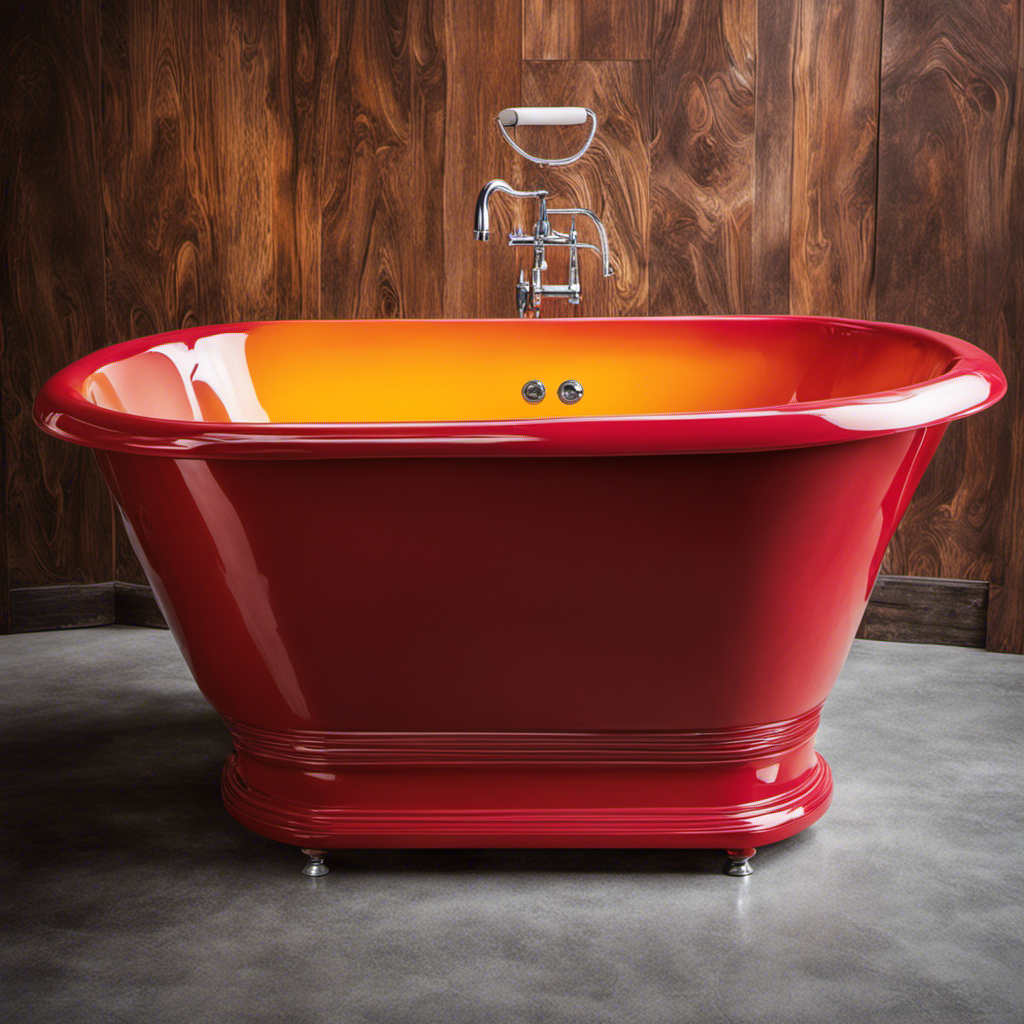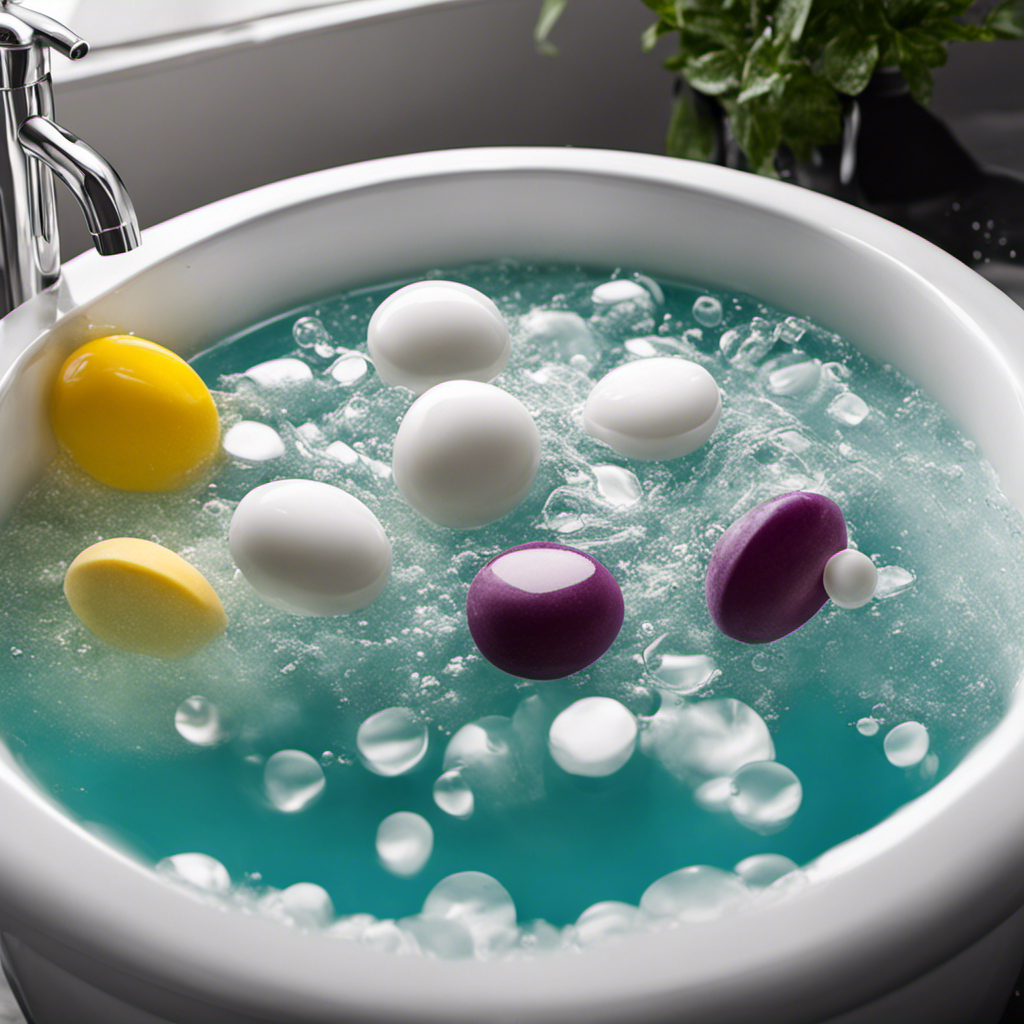As someone who loves a relaxing soak in the tub, I know firsthand the importance of a well-maintained bathtub.
But what happens when your bathtub is beyond repair? That’s when the question arises: How much does it cost to replace a bathtub?
In this article, I’ll break down the average cost of bathtub replacement, factors that can affect the cost, and whether it’s worth it to hire a professional or tackle the job yourself.
Let’s dive in and find out!
Key Takeaways
- The average cost of replacing a bathtub is around $3,000.
- Material options for bathtub replacement include acrylic, fiberglass, porcelain-enameled steel, and cast iron.
- Factors that affect the cost of bathtub replacement include the size and type of bathtub chosen, the materials used, the complexity of the installation process, and whether a professional contractor is hired.
- DIY options for bathtub replacement can save on costs, but there is a risk of costly mistakes. Hiring a professional ensures correct and safe installation, but it comes at a higher cost.
Average Cost of Bathtub Replacement
The average cost of replacing a bathtub is around $3,000.
When it comes to bathtub replacements, there are various material options available. These options include acrylic, fiberglass, porcelain-enameled steel, and cast iron.
Acrylic is a popular choice due to its durability, ease of maintenance, and affordability. Fiberglass is another cost-effective option that is lightweight and easy to install. Porcelain-enameled steel offers a classic look and is known for its durability. However, it can be prone to chipping and scratching. Cast iron is a more expensive option but is extremely durable and offers a luxurious feel.
Along with material costs, labor costs also need to be considered. On average, labor costs for bathtub replacement can range from $500 to $1,000, depending on factors such as the complexity of the installation and the location of the bathroom.
Factors Affecting Bathtub Replacement Costs
When it comes to replacing your bathtub, you’ll want to consider a few factors that can affect the overall cost.
First and foremost, the size and type of bathtub you choose will play a significant role in determining the cost. Larger or more luxurious bathtubs will generally be more expensive than smaller or standard ones.
Additionally, the materials used for the bathtub, such as acrylic, fiberglass, or cast iron, can also impact the cost.
Other factors to consider include the complexity of the installation process, any necessary plumbing changes, and the cost of hiring a professional contractor.
To save on costs, you can consider doing some of the work yourself, such as removing the old bathtub or painting the walls. However, it’s important to weigh the potential savings against the risk of making costly mistakes.
Speaking of cost-saving tips, let’s now delve into the details of the cost of DIY bathtub replacement.
Cost of DIY Bathtub Replacement
If you want to save money, you can consider tackling the DIY bathtub replacement yourself. It is a cost-effective option that allows you to customize the process according to your preferences.
Here are some important factors to consider when estimating the cost of DIY bathtub replacement:
-
Bathtub replacement materials: You will need to purchase a new bathtub, which can range in price depending on the material. Options include acrylic, fiberglass, cast iron, and porcelain. Prices can vary from a few hundred dollars to several thousand.
-
Cost of bathtub removal: Removing the old bathtub may require tools such as a reciprocating saw, pry bar, and a hammer. Additionally, you may need to rent a dumpster for disposal, which can add to the overall cost.
-
Plumbing and electrical work: If you are changing the location of the bathtub or upgrading fixtures, you may need to hire a professional to handle the plumbing and electrical aspects.
-
Additional expenses: Consider the cost of any necessary permits, as well as any unexpected repairs that may arise during the process.
Cost of Hiring a Professional for Bathtub Replacement
Hiring a professional for bathtub replacement can be a convenient option, as they will handle all the necessary plumbing and electrical work. Not only does this save you time and effort, but it also ensures that the job is done correctly and safely. When considering the cost of hiring a professional, it is important to understand the breakdown of expenses. The table below provides a breakdown of the average costs associated with bathtub replacement:
| Cost Component | Average Cost |
|---|---|
| Bathtub | $500-$1,500 |
| Labor | $500-$1,000 |
| Plumbing and Electrical Work | $500-$1,000 |
| Total Cost | $1,500-$3,500 |
To find affordable bathtub replacement services, it is recommended to compare quotes from different professionals or companies. Additionally, consider looking for any ongoing promotions or discounts that may be available. It is important to prioritize quality and expertise when selecting a professional, as the long-term durability and functionality of your new bathtub depend on it.
Additional Costs to Consider for Bathtub Replacement
When it comes to bathtub replacement, there are a few additional costs that homeowners should be aware of.
One such cost is the plumbing and installation fees, which can vary depending on the complexity of the project and the location of the bathroom. These fees cover the cost of removing the old bathtub, installing the new one, and connecting the plumbing fixtures.
Another expense to consider is upgrading fixtures and accessories, such as faucets, showerheads, and towel bars. These upgrades can enhance the overall look and functionality of the bathroom, but they do come at an additional cost.
Plumbing and Installation Fees
The cost of replacing a bathtub includes plumbing and installation fees. When it comes to plumbing, there are a few factors that can affect the cost.
First, you may need to hire a plumber to disconnect and reconnect the water supply lines and drain pipes. This can range from $150 to $300 depending on the complexity of the job.
Second, if your new bathtub requires electrical connections for features like jets or lighting, you may need an electrician to handle the wiring. Electrical fees can range from $100 to $500 or more, depending on the extent of the work required.
Lastly, there may be hidden costs such as repairing any damage to the surrounding walls or floor, which can add to the overall expense.
With these considerations in mind, it’s important to budget for both plumbing and electrical fees when replacing a bathtub.
Now, let’s move on to the next section about upgrading fixtures and accessories.
Upgrading Fixtures and Accessories
After considering the plumbing and installation fees for replacing a bathtub, it’s important to think about the aesthetic aspects of the upgrade.
Upgrading bathroom fixtures can greatly enhance the overall look and feel of your bathroom. When choosing the right bathtub accessories, you’ll want to consider the style, functionality, and durability.
Think about whether you prefer a traditional or modern design, and whether you need features like handrails or grab bars for accessibility. Additionally, selecting high-quality materials such as stainless steel or chrome can ensure longevity and resistance to water damage.
Upgrading fixtures and accessories can add a personal touch and elevate the overall ambiance of your bathroom.
Now, let’s move on to the next section and delve into the cost comparison between bathtub replacement and refinishing.
Cost Comparison: Bathtub Replacement Vs. Refinishing
Replacing a bathtub can be more expensive than refinishing it. Not only does bathtub replacement require purchasing a new tub, but it also involves the cost of labor for demolition and installation. On the other hand, refinishing can give your existing bathtub a fresh, new look without breaking the bank. Here are some benefits of bathtub refinishing:
- Cost-effective: Refinishing is significantly cheaper than replacing a bathtub.
- Time-saving: Refinishing can be completed in just a few hours, while replacing a bathtub can take days.
- Eco-friendly: Refinishing eliminates the need to dispose of an old tub, reducing waste.
- Customizable: With refinishing, you have the option to choose a new color or finish for your bathtub.
The bathtub refinishing process involves thoroughly cleaning the tub, repairing any chips or cracks, applying a primer, and then spraying on a new coating. This process can extend the life of your bathtub and give it a fresh, updated appearance.
Tips for Saving Money on Bathtub Replacement
When it comes to replacing a bathtub, there are several key points to consider in order to save money.
Firstly, exploring budget-friendly alternatives to traditional bathtubs can significantly reduce costs without compromising on quality.
Additionally, deciding between a DIY installation or hiring a professional can have a significant impact on the overall expenses.
Lastly, negotiating with contractors to get the best price possible is a skill that can help homeowners stay within their budget.
Budget-Friendly Bathtub Alternatives
If you’re on a budget, there are cost-effective alternatives to replacing a bathtub. One option is bathtub remodeling, which involves changing the appearance of your existing bathtub without the need for a full replacement.
This can be done through bathtub resurfacing, where a new layer of material is applied to the existing surface to give it a fresh and updated look. Another alternative is bathtub liners, which are custom-made acrylic liners that fit over your existing bathtub, providing a new and durable surface.
Additionally, you can consider bathtub refinishing, which involves repairing any chips or cracks in your bathtub and then applying a new finish to restore its original shine. These alternatives can save you money while still giving your bathtub a new lease on life.
Now, let’s explore the options of DIY versus professional installation.
DIY Vs Professional Installation
One option to consider is whether you want to tackle the project yourself or hire a professional for bathtub installation. There are pros and cons to both approaches.
| DIY Installation | Professional Installation |
|---|---|
| Cost-effective | Expertise and experience |
| Flexibility in schedule | Efficient and timely |
| Sense of accomplishment | Higher quality work |
| Potential for mistakes | Added expense |
DIY installation can save you money, as you won’t have to pay for professional expertise. It also allows you to work at your own pace and gives you a sense of accomplishment. However, there is a risk of making mistakes, which can be costly to fix.
Hiring a professional ensures that the job will be done efficiently and with high quality. They have the necessary expertise and experience to handle any challenges that may arise. However, this option can be more expensive and may require you to work around their schedule.
Considering these factors, it’s important to weigh the pros and cons before making a decision. Ultimately, it depends on your level of confidence and willingness to take on the project yourself.
Now that you’ve decided whether to go DIY or hire a professional, the next step is to negotiate contractor prices.
Negotiating Contractor Prices
To get the best deal, you should research and compare different contractor prices before making a decision. Negotiating contractor prices can help you save money and ensure you are getting the most cost-effective alternatives for your bathtub replacement.
Here are some tips to keep in mind:
- Ask for multiple quotes from different contractors to compare prices.
- Don’t be afraid to negotiate and ask for discounts or lower rates.
- Consider the reputation and experience of the contractor before finalizing the deal.
- Look for contractors who offer package deals or discounts for multiple services.
By negotiating contractor prices, you can find a balance between quality and affordability for your bathtub replacement project. This will help you make an informed decision and budget effectively for the project.
Now, let’s move on to the next section about budgeting for bathtub replacement: what to expect.
Budgeting for Bathtub Replacement: What to Expect
When budgeting for bathtub replacement, you should expect to factor in the cost of both the new tub and the installation fees. There are several bathtub replacement alternatives available, ranging from basic acrylic tubs to luxurious freestanding tubs. The cost breakdown of bathtub replacement can vary depending on factors such as the type of tub, the size of the bathroom, and any additional features or upgrades. To give you an idea of the potential costs involved, here is a breakdown of the average prices for different types of bathtubs and their installation fees:
| Bathtub Type | Average Cost | Installation Fee |
|---|---|---|
| Acrylic | $500 – $1,500 | $500 – $1,000 |
| Fiberglass | $700 – $2,000 | $800 – $1,200 |
| Cast Iron | $1,200 – $5,000 | $1,000 – $2,500 |
| Freestanding | $2,000 – $10,000 | $1,500 – $3,000 |
Remember that these prices are just estimates and can vary depending on your specific circumstances. It’s always a good idea to get multiple quotes from contractors to ensure you’re getting the best price for your bathtub replacement project.
Frequently Asked Questions
Can I Replace My Bathtub Myself if I Have No Prior Experience With Plumbing or Construction?
I can replace my bathtub myself even without prior experience in plumbing or construction. It’s possible with the help of a bathtub replacement tutorial and some tips for first-time bathtub replacement.
What Are the Potential Risks or Drawbacks of DIY Bathtub Replacement?
There are several risks involved and drawbacks to consider when attempting a DIY bathtub replacement. These include potential water damage, improper installation leading to leaks, and the need for specialized tools and knowledge.
Are There Any Hidden Costs or Unexpected Expenses That I Should Be Aware of When Replacing a Bathtub?
When it comes to replacing a bathtub, there can be hidden costs and unexpected expenses. It’s important to be aware of these potential surprises so you can budget accordingly and avoid any financial setbacks.
Are There Any Special Permits or Licenses Required for Hiring a Professional to Replace a Bathtub?
Permit requirements and licensing regulations vary by location when hiring a professional to replace a bathtub. It is important to check with local authorities to ensure compliance with any necessary permits or licenses.
How Long Does the Average Bathtub Replacement Process Take From Start to Finish?
On average, a bathtub replacement process takes around 2-3 days. The steps involved include removing the old bathtub, preparing the area, installing the new bathtub, and making any necessary adjustments or repairs.
Conclusion
After carefully considering all the factors involved, I’ve come to the conclusion that the cost of replacing a bathtub can vary greatly depending on various factors such as materials, labor, and additional features.
However, this investment is not just about the monetary value, but also about the symbol of renewal and rejuvenation it represents. By replacing your bathtub, you’re not only enhancing the aesthetic appeal of your bathroom, but also creating a space for relaxation and self-care.
It’s a worthwhile expense that can bring a sense of luxury and comfort to your daily routine.










